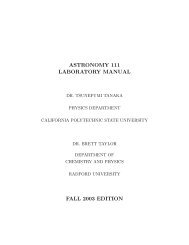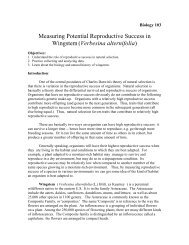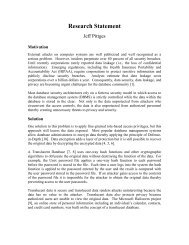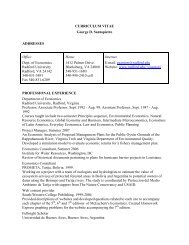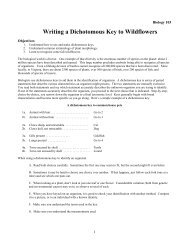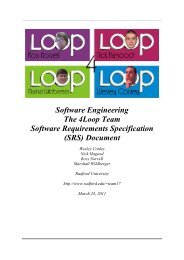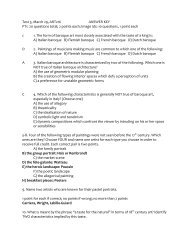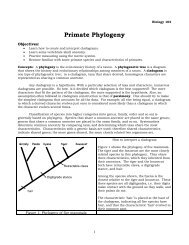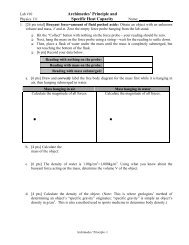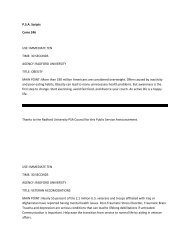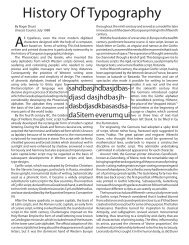lab 2; Jan 30 â velocity, acceleration
lab 2; Jan 30 â velocity, acceleration
lab 2; Jan 30 â velocity, acceleration
Create successful ePaper yourself
Turn your PDF publications into a flip-book with our unique Google optimized e-Paper software.
Velocity and Acceleration<br />
Physics 111<br />
<br />
A. Velocity: instantaneous <strong>velocity</strong> vector, v = Δx<br />
/ Δt<br />
.<br />
Name:<br />
An object is moving at a constant speed of 10.0 cm/second along the curved path below. Each of the<br />
pairs of dots represents the object at two closely-spaced times. For example, the object is initially at<br />
Point A, then at Point A’ an instant later. An instant after it’s at Point B it’s at Point B’.<br />
A A’<br />
B<br />
B’<br />
F<br />
F’<br />
G G’<br />
X<br />
C<br />
C’<br />
D<br />
D’<br />
E<br />
E’<br />
[4 pts] On each of the pairs of dots above, draw an arrow straight from A to A’, then from B to B’, etc.<br />
Each of these short arrows is the displacement Δ x from one point to the next.<br />
<br />
The <strong>velocity</strong> of the object is given by v = Δx<br />
/ Δt<br />
. Thus the <strong>velocity</strong> at Point A points in the same<br />
direction as the Δ x arrow that starts at Point A.<br />
[2 pts] Does the <strong>velocity</strong> at B point in the same direction as the <strong>velocity</strong> at A? yes no (circle<br />
one)<br />
[4 pts] Extend each arrow above until each is exactly 2.0cm long. Let each of these long arrows<br />
represent the 10.0 cm/sec <strong>velocity</strong> of the object at each point. These are called the “instantaneous<br />
<strong>velocity</strong> vectors” at each point.<br />
[2 pts] Each vector that you just drew starts at one point, and has their direction determined by where<br />
the object is just an instant later. These vectors lie along the path, parallel to the path at each location.<br />
There's one word that describes such vectors—what is that word?<br />
Two students have the following disagreement:<br />
Student #1: “Why bother to try to measure the distance and time between points that are as close<br />
together as, say, D and D’ to get the speed? I'd just pick two easy points such as D and E, measure<br />
their separation, and calculate the <strong>velocity</strong> from there.”<br />
Student #2: “No way norker. Look at point ‘X.’ You’re going to get the speed and the direction<br />
wrong if you pick points that far apart.”<br />
With which student do you agree? State your answer and explain your reasoning in the space below.<br />
Have this<br />
answer<br />
checked<br />
before<br />
proceeding.<br />
Velocity and Acceleration—1
Velocity and Acceleration<br />
Physics 111<br />
Name:<br />
<br />
B. Acceleration: instantaneous <strong>acceleration</strong> vector, a = Δv<br />
/ Δt<br />
.<br />
An object below is moving along a circular path at a constant speed of <strong>30</strong>.0 cm/sec. The pairs of points<br />
(A & A’, B & B’, etc.) show the object at times that are 0.10 second apart.<br />
A’<br />
B<br />
B’<br />
C<br />
Point B is<br />
exactly at the<br />
top of the<br />
circle.<br />
A<br />
C’<br />
D<br />
D’<br />
[4 pts] You know velocities are always tangent to the path of motion. On the diagram above, draw<br />
tangent vectors at each of the 8 points that are exactly 1.0cm long. These will represent the <strong>velocity</strong> of<br />
the object at those points. Be careful with the directions your arrows.<br />
[6 pts] As the object goes around this circle,<br />
Is the magnitude of v changing? yes no (circle one)<br />
Is the direction of v changing? yes no (circle one)<br />
Is the total <strong>velocity</strong> v changing as the object goes around this circle? yes<br />
no (circle one)<br />
The <strong>velocity</strong> at point A, v A<br />
had to change to become the <strong>velocity</strong> at point A’, v A'<br />
. This change is the<br />
vector Δ v AA'<br />
, called the “change in <strong>velocity</strong>.” The vector Δ v AA'<br />
compares the two vectors v A<br />
and v A'<br />
.<br />
[10 pts] Construct the change in <strong>velocity</strong> vectors, v Δ by doing the following:<br />
• Move the tail of v <br />
A'<br />
back so that it starts at Point A. Don’t change the magnitude or direction.<br />
• Draw an arrow from the tip of the original <strong>velocity</strong> v A<br />
to the tip of v A'<br />
. This new arrow is<br />
Δ v AA'<br />
.<br />
• Do this for the remaining 3 pairs of <strong>velocity</strong> vectors.<br />
[2 pts] Each of the Δ v vectors points in a common direction. What is that direction?<br />
Velocity and Acceleration—2
Physics 111<br />
Velocity and Acceleration<br />
Name:<br />
Now the object is speeding up (A to A’), slowing down (B to B’), and finally just turning (C to C’).<br />
15 mm/sec<br />
A’<br />
15 mm/sec<br />
B<br />
B’<br />
10 mm/sec<br />
C<br />
10 mm/sec<br />
The speeds of<br />
the object are<br />
listed next to<br />
each point.<br />
10 mm/sec<br />
A<br />
C’<br />
10 mm/sec<br />
[6 pts] On the diagram above, draw vectors that correctly represent the <strong>velocity</strong> of the object at each<br />
point. To get the scale correct, if the object is moving at 10 mm/s, draw a vector that is 10 mm long; if<br />
the object is moving at 17 mm/s, draw a vector that is 17 mm long; etc.<br />
[10 pts] Construct the change in <strong>velocity</strong> vectors, Δ v , as before:<br />
• Redraw v <br />
A'<br />
with its tail starting at Point A. Again, keep the magnitude and direction the same.<br />
• Draw an arrow from the tip of the original <strong>velocity</strong> v A<br />
to the tip of v A'<br />
. This new arrow is<br />
Δ v AA'<br />
.<br />
• Do this for the remaining 3 pairs of <strong>velocity</strong> vectors.<br />
[4 pts] The object is moving at a constant speed between points C and C’. What is the angle between<br />
Δ v CC'<br />
and the original vector v C<br />
?<br />
[4 pts] The object is speeding up between points A and A’. What is the angle between Δ v AA'<br />
and the<br />
original vector v A<br />
? (Hint: How does this angle compare to, say something familiar such as 90 0 ?)<br />
[4 pts] The object is slowing down up between points B and B’. What is the angle between Δ v BB'<br />
and<br />
the original vector v B<br />
?<br />
The <strong>acceleration</strong> of an object is always in the same direction as its change in <strong>velocity</strong>, Δ v . You can see<br />
<br />
this from the definition of <strong>acceleration</strong>: a = Δv<br />
/ Δt<br />
. Since this is physics, things are “always” or<br />
“never.” In the space below, make a general rule for how the directions of the <strong>acceleration</strong> a and<br />
<strong>velocity</strong> v tells you whether an object is only turning, if it is speeding up and turning, or if it is slowing<br />
down and turning.<br />
Velocity and Acceleration—3
Physics 111<br />
<br />
C. Application: a = Δv<br />
/ Δt<br />
.<br />
Velocity and Acceleration<br />
Name:<br />
On the previous pages you have seen that the direction of the <strong>acceleration</strong> vector can tell you whether<br />
an object is speeding up, slowing down, or turning:<br />
• If part of the <strong>acceleration</strong> a points in the same or opposite direction as the <strong>velocity</strong> v , then the<br />
object will be speeding up or slowing down.<br />
• If part of a is pointed at a 90 0 angle to a then this will turn the object.<br />
One example of these two situations is illustrated in the figure below. This <strong>acceleration</strong> vector has one<br />
component along v <br />
initial<br />
and speeds the object up. But a has another component perpendicular to v initial<br />
;<br />
this turns the object.<br />
Object<br />
a <br />
this part of a <br />
speeds up the object<br />
this part of a turns object<br />
[10 pts] Various objects are shown below. The initial <strong>velocity</strong> vectors v <br />
initial<br />
as well as the <strong>acceleration</strong><br />
vectors a for each object are shown. Use your general rule above to determine the subsequent motion<br />
of each of the objects (i.e., whether it is speeding up and turning, only turning, only slowing down,<br />
etc.).<br />
v<br />
initial<br />
Notice how<br />
comparing<br />
these vectors<br />
requires them to<br />
be tail-to-tail.<br />
Object<br />
a <br />
v<br />
initial<br />
Object<br />
a <br />
v<br />
initial<br />
Object<br />
a <br />
v<br />
initial<br />
a <br />
v<br />
initial<br />
Object<br />
Object<br />
a <br />
v<br />
initial<br />
Turn these sheets in for the <strong>lab</strong> grade.<br />
Velocity and Acceleration—4



